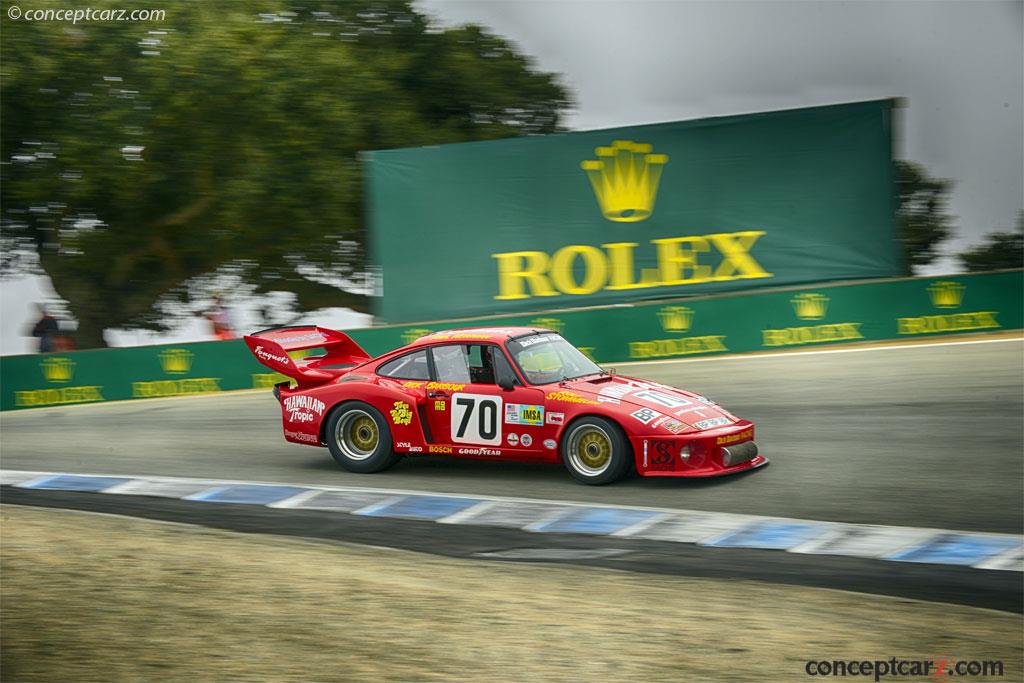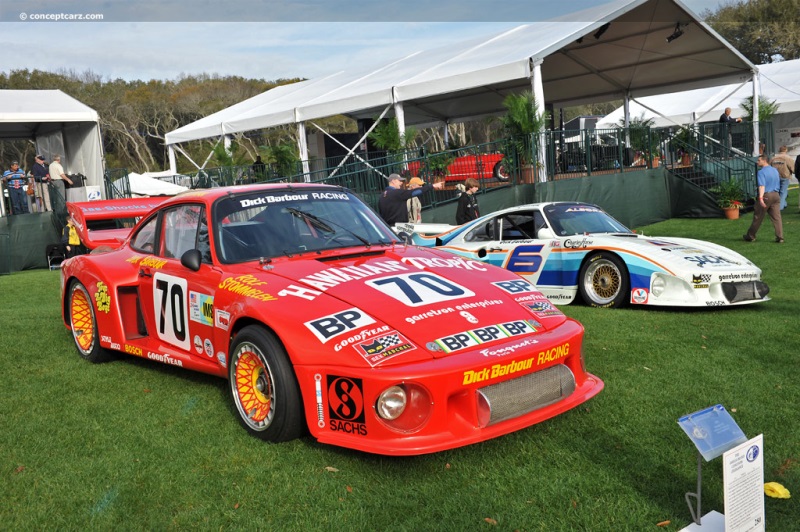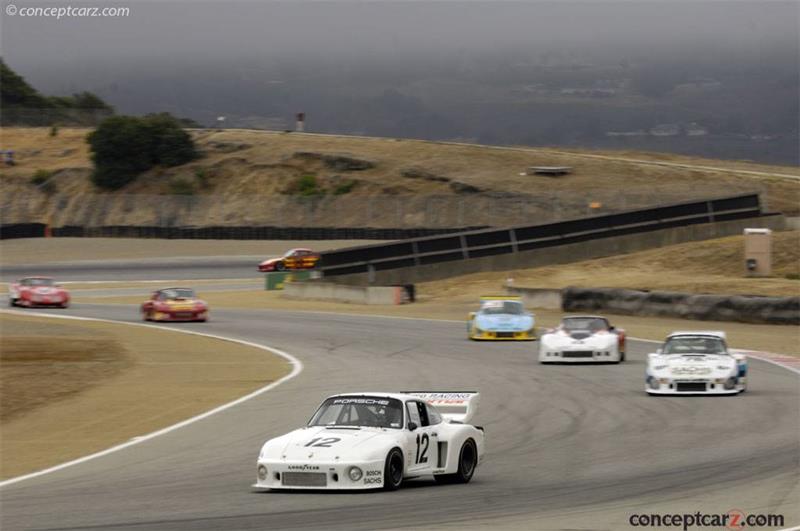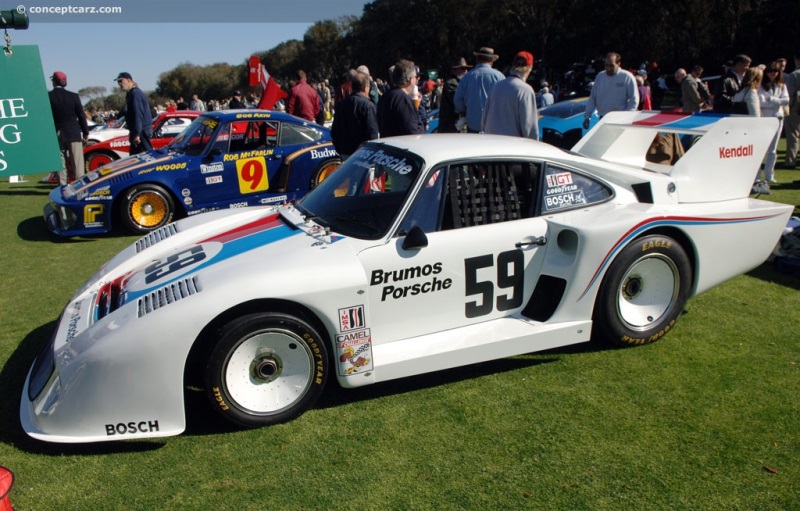1979 Porsche 935 Navigation
The Porsche 934 was introduced for the 1976 season as a Group 4 variant of the all-new turbocharged 930. The 930 was a factory-built racing machine that was based on its road car counterpart. The Porsche 935 was developed to compete in the Group 5 category and was an evolution of the RSR 2.1 Turbo. It was given a fully independent coil-spring suspension, turbocharged twin-plug flat-six engine, and aerodynamic fiberglass bodywork. During its debut season, the new Martini-liveried works 935s won the Group 5 championship.
Coupe
Chassis #: 935 0090030
View info and history
Auction entries : 1The Porsche 935/76
Known as the Porsche 935/76, the new Porsche 935 and its sibling, the Porsche 936, would capture the FIA World Championship for Makes for Group 5 special production and the World Sportscar Championship for Group 6 prototypes up to 3.0 Liters, along with a victory at Le Mans. The Group 5 competition was known as the 'silhouette formula' and allowed for significant modifications to be made to the bodywork and the addition of wider axles, larger fenders, wings, and water cooling. Rules specified that the basic silhouette of the car should not be altered when viewed from the front. Some of the customer Porsche 934 cars were modified to conform to Group 5 specifications with body kits supplied by Porsche, these are often known as 934/5. With sponsorship from Martini Racing, the Porsche 935s contested the seven-race season with factory drivers Jacky Ickx and Jochen Mass. These drivers also raced in Formula 1 competition, so when there was a schedule conflict, Rolf Stommelen and Manfred Schurti were the backup drivers.
Coupe
Chassis #: 009 0029
View info and historyMass and Ickx won with the 935 at the first two races of the season, at Mugello Circuit and at Vallelunga. A 935 K1 entered by Cologne-based Kremer Racing placed second at the six-hour Mugello. Porsches occupied the first seven places ahead of a BMW in eighth, giving Porsche valuable points that they would need later in the season. A BMW placed second at Vallelunga and the best 934 placed fifth.With two convincing victories and very little competition in sight, the CSI enforced a rule requiring the 'whale tail' hood of the road-going 930 to be installed on the race car. This was problematic for Porsche as its air-to-air intercooler setup required alterations for a more compact air-to-water layout. The company sent half a million Deutsche markets and several weeks of testing to resolve the issue.The third event of the season was the six-hour Silverstone, where a 935 received the pole position but placed tenth in the race due to a clutch issue. The number 4 Hermetite BMW 3.5 CSL driven by John Fitzpatrick and Tom Walkinshaw took the checkered flag. A Kremer 935 placed second, beating a privately entered BMW 3.5 CLS by just a second. 
Coupe
Chassis #: 0090001The Silverstone race had revealed a potential problem for Porsche, as BMW Motorsport had entered a highly competitive turbocharged 3.2 CSL. During qualifying, it was just a second behind the factory Porsche 935 and two seconds ahead of the Kremer 935. During the race, it retired due to a gearbox problem. The 3.5 CSL had proven to be both fast and reliable, and the number 7 Schnitzer Motorsport 3.5 CSL would capture victory at the Nurburgring with Albrecht Krebs and Dieter Quester at the wheel. Quester and Nilsson would drive the #12 Schnitzer Motorsport BMW 3.5 CSL to victory at Österreichring and Rolf Stommelen and Manfred Schurti placed first in a 935 at Watkins Glen. BMW won during the middle of the season as Porsche continued to work on its 'whale tail' issue. The 935s initially wore fender-mounted headlights in two different configurations depending on the track. For high-speed tracks, it used a more aerodynamic setup. This was the preferred setup. For sprint races, it used a wider version of its wheel arches. Mid-way through the season, Porsche engineers (mostly Norbert Singer) discovered a loophole that allowed modifications of the fenders which permitted the removal of the headlights to reduce drag and create more downforce. With the headlights positioned in the front spoiler, this configuration became known as the 'flat nose' or 'slant nose' configuration and would become one of the most distinguishable features of the 935. This style was later emulated by the road-going 930 and known as the flachbau, or 'flatnose.' In the back, the 935s now wore extended 'long tail' rear fenders which accommodated additional space for engine components and aided in cooling. Going into the final race of the season, either BMW or Porsche could have claimed the victory with a win at Dijon. BMW had won on three occasions, along with a second and fourth-place finish, giving them 85 points. Porsche had also won three times but with two-second place finishes, they had a slight advantage with ninety points. 
Coupe
Chassis #: 0000029
Auction entries : 1The turbocharged BMW Motorsport car returned, joined by the 3.5 L CSL, and quickly proved they were the car to beat with Peterson and Nilsson setting the pole, albeit a half a second ahead of Ickx. During the six-hour race, the transmission failed on the 750 horsepower Bavarian Motor Works car, allowing three 935s plus two Group 5 spec 934/5s to cross the finish ahead of the naturally aspirated BMW. 935/76 at Le Mans
The 1976 Le Mans 24 Hours race did not count towards either world championship, but it was nonetheless a very important race. A Renault Alpine set the pole and a 935 driven by Rolf Stommelen and Manfred Schurti qualified third and would finish the race fourth overall. The overall victory was earned by a Porsche 936. A 911 Carrera RSR placed 6th and a 908/3 Turbo placed 7th. In 9th place was a Porsche 3.0-liter turbocharged 934 and a 934/5 placed 11th.The 935 at LeMans was equipped with a 2.85-liter flat-6 engine augmented by a KKK turbocharger and its chassis weighed 900 kg, well under the 970 kg minimum stipulated for a 4.0-liter car, thus allowing ballast to improve weight distribution. The bodywork had the lights recessed into the front spoiler. The Porsche 935/77
The updated 935/77 was introduced for the 1977 season. The works team constructed 13 examples of the 935 for customer use (935/77A), wearing chassis numbers 930 770 0901 to 930 770 0913. The appearance and specification were similar to the works 935/76 and achieved great success in competition, particularly in the German DRM series. Most of the privateers were based in Italy, Australia, Germany, the United States, and France.The Deutsche Rennsport Meisterschaft (DRM) was a drivers' championship that conformed to Group 5 rules. The Porsches initially had little competition as the naturally aspirated BMW Coupes and Ford Capri had pulled out of the Division 1 (over 2.0 liter) competition. This changed when turbocharged models such as the Zakspeed Ford Capri, Toyota Celica, and BMW-powered Schnitzer threw their hats into the ring. Nonetheless, the 934 would dominate their division during the 1976 season and the 935 in 1977. The factory team focused their attention on another victory at Le Mans and remaining competition in the World Championship for Makes. Porsche had won both world championships in 1976, and with little else to prove and a lack of competition, Porsche did not defend its sportscar championship with the 936 in 1977. For the 1978 season, the series was demoted to a European series and was later discontinued. One or two factory entered 935/77 were raced during the 1977 season, winning four of the nine events. Their biggest competition was their unreliability which plagued them throughout the season. Rolf Stommelen and Manfred Schurti won the Mugello (round 2), and Jochen Mass and Jacky Ickx won Silverstone (round 3), Watkins Glen (round 5), and Brands Hatch (round 7).
Coupe
Chassis #: 0000029
Auction entries : 1The factory-prepped 935/77 had various improvements to its bodywork to lower drag and increase airflow to the mechanical components. The front fenders now protruded above the hood line, the rear fenders were also altered, and a second rear window was added above the standard one. The single turbo was later replaced by two KKK units which improved throttle response and boosted power but were also more prone to head gasket failure. The Porsche 935/78
Seventeen customer Porsche 935 chassis were built for the 1978 season, inspired by the works 935/77s. These cars were numbered 930 890 0011 to 930 890 0037 and equipped with twin-turbocharged engines, removable rear fenders, and 'running board' rocker panels. As the 1978 season was coming to a close, Porsche constructed seven 935 chassis for private teams in the United States. These 1979-model cars were numbered 930 990 0026 to 930 990 0032. The exterior was similar to the 1978-model customer's cars but was equipped with several modifications and features, including an inverted gearbox and larger brakes. The engines received a large single turbocharger, which helped it achieve higher top speeds at Daytona. Many of these, however, was eventually converted to a more versatile, twin-turbocharger arrangement.
Coupe
Chassis #: 9307700958Porsche entered a modified 935/77 in the 2.0 liter Division II of the DRM. It used an air-cooled flat-six engine with a displacement size of 1,425cc and produced approximately 350 horsepower. Additionally, rules allowed for weight to be lowered to 750 kg, which Porsche engineers accomplished by removing parts of the chassis and replacing them with a tubular aluminum space frame. The car's first outing was at Norisring in early July 77 but suffered from overheating. Porsche sat out the next round at Diepholz airfield and returned for the DRM support race of the 1977 German Grpix Prix. Driven by Jacky Ickx, the 935 (known as Baby due to its smaller 1.4-liter turbocharged engine - chassis number 935/2-001) set the pole position by nearly three seconds and won the race by fifty seconds, setting the fastest lap in the process. The Porsche 935/78
The final version of the 935 was drastically different from the iterations that preceded it. It used a 3.2-liter engine, did away with air cooling in favor of water-cooled cylinder heads, and produced upwards of 850 horsepower. Porsche had their eyes set on Le Mans, and since the track was run clockwise, the bodywork and weight distribution were shaped to take full advantage of the long, high-speed track. The body was lowered by 3.9 inches, and the floor pan was cut away to mount the exhaust system at the front of the engine. The gearbox was mounted upside down to reduce the angle of the drive shafts and the driver seat was moved over to the right side. Additional fairings were added to the doors, bridging the gap between the front and rear fenders.
Coupe
Chassis #: 935 0090030
View info and history
Auction entries : 1The Porsche 935/78 was known as the 'Moby Dick' due to its white color scheme and long tail shape. Mass and Ickx drove it to victory at the 6 Hours of Silverstone, setting the pole position and the fastest lap in the process. Silverstone had been a testing ground for the 935, to determine its issues (if any) and figure out if any additional updates were needed. Having proven its reliability and competitiveness, the team focused its attention on Le Mans. The Porsche 935/78, with its 3.2-liter engine, achieved a record top speed of 228 mph on the straight in LeMans, making them faster than the 936 and the RenaultAlpine. Before the race, the engine had to be replaced, and with ensuring problems during the early stages of the race, the Moby Dick failed to reach its potential, finishing 8th overall behind three customers 935. A Renault Alpine finished ahead of a pair of 936s to claim the overall victory. Porsche raced the 935/78 at Vallelunga and at the Norisring before retiring it to their museum. The 1979 and 1980 Season
Porsche did not officially contest either the 1979 or 1980 season, leaving these duties to privateer 935, 936, 908 and 917 (albeit with some factory support - mostly in spare parts and knowledge). Racing Accomplishments
The Porsche 935 was very competitive and successful, winning over 150 races worldwide through 1985, which included an outright victory at the 1979 24 Hours of Le Mans, and over 20 class victories. They won the 24 Hours of Daytona and the 12 Hours of Sebring six times each. Between 1977 and 1979, they were undefeated in the German DRM. From 1976 to 1979, they earned Porsche victory in the FIA World Championship for Makes.
Coupe
Chassis #: 009 0029
View info and historyA 935 driven by Alan Jones won the 1982 Australian GT Championships, having been undefeated for the whole season. The same car, this time with Rusty French driving, was also the 1983 Australian GT Championship. After 1982, Group 5 was discontinued by FIA. The 935 continued to race in IMSA's GTP category. The final major victory for the 935 was in the 1984 12 Hours of Sebring in the IMSA GTP class. The 935 raced in two raced in the 1986 seasons.Specifications
All of the Porsche 935 models had an 89.4-inch wheelbase except for the 935/78 which used an 89.7-inch wheelbase platform. The length measured 189.8-inches, a width of 78.1-inches, and a height of 45.3-inches. The 935/78 had different specifications with a length of 192.5-inch, a width of 78.3-inches, and a height of 47.2-inches.
Coupe
Chassis #: 00900001It had a unitary steel chassis clothed with a fiberglass body and fitted with ventilated and cross-drilled disc brakes at all four corners. The fully-independent suspension used MacPherson struts at the front with lower wishbones and adjustable anti-roll bars. At the back were coil springs over shock absorbers and semi-trailing arms. The development of the Group 5 Porsche 935 from the 934 Turbo of 1974 was led by Norbert Singer. The 2.85-liter flat-6 engine was augmented by a KKK (Kühnle, Kopp & Kausch) turbo and the overall chassis weighed 900 kg. The flat-six engine powering the 935 produced approximately 590 horsepower at 7,900 RPM and 438 lb-ft (588 Nm) of torque at 5,400 RPM. It had an aluminum block and head, two valves per cylinder, single overhead camshafts, a bore of 3.8-inches, and a stroke of 2.8-inches. The turbocharger boost was between 1.35 and 1.55. The engine was paired with a four-speed manual transmission without a differential. Specifications varied, and with the help of twin KKK K27 turbochargers and Bosch Mechanical fuel injection, it offered upwards of 750 horsepower at 8,200 RPM.
by Daniel Vaughan | Oct 2019
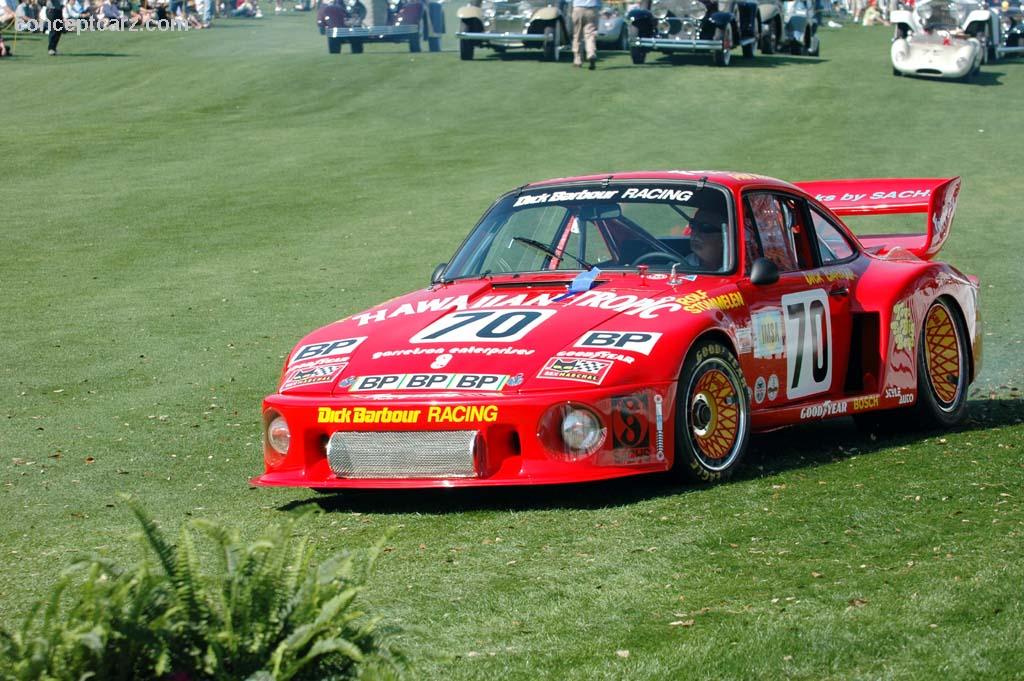
Coupe
Chassis #: 935 0090030
View info and history
Auction entries : 1
Known as the Porsche 935/76, the new Porsche 935 and its sibling, the Porsche 936, would capture the FIA World Championship for Makes for Group 5 special production and the World Sportscar Championship for Group 6 prototypes up to 3.0 Liters, along with a victory at Le Mans. The Group 5 competition was known as the 'silhouette formula' and allowed for significant modifications to be made to the bodywork and the addition of wider axles, larger fenders, wings, and water cooling. Rules specified that the basic silhouette of the car should not be altered when viewed from the front. Some of the customer Porsche 934 cars were modified to conform to Group 5 specifications with body kits supplied by Porsche, these are often known as 934/5. With sponsorship from Martini Racing, the Porsche 935s contested the seven-race season with factory drivers Jacky Ickx and Jochen Mass. These drivers also raced in Formula 1 competition, so when there was a schedule conflict, Rolf Stommelen and Manfred Schurti were the backup drivers.

Coupe
Chassis #: 009 0029
View info and history
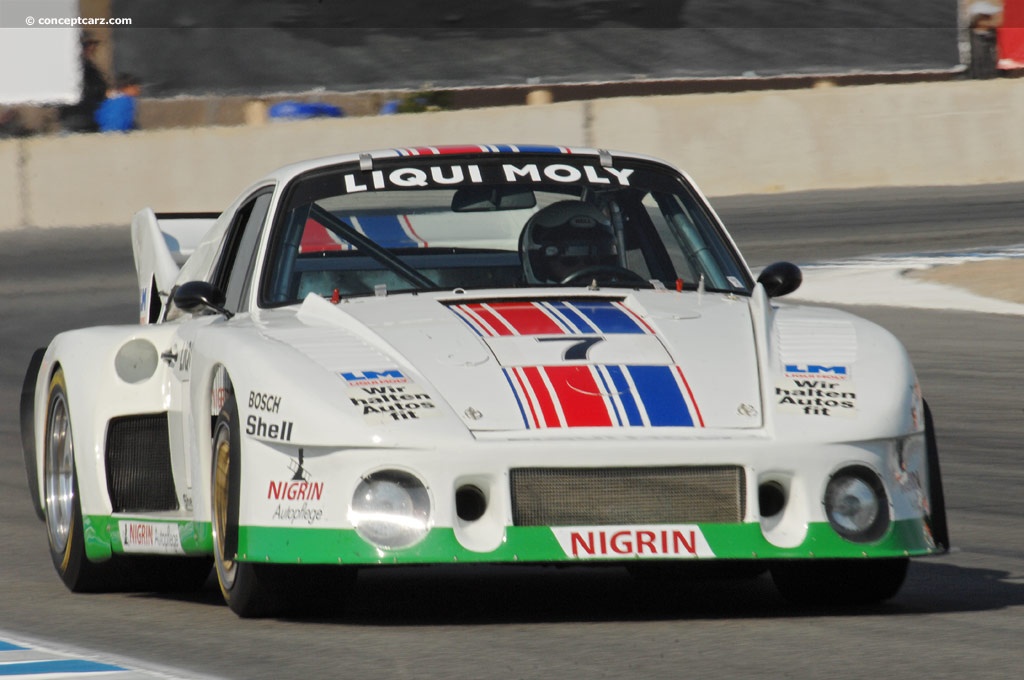
Coupe
Chassis #: 0090001
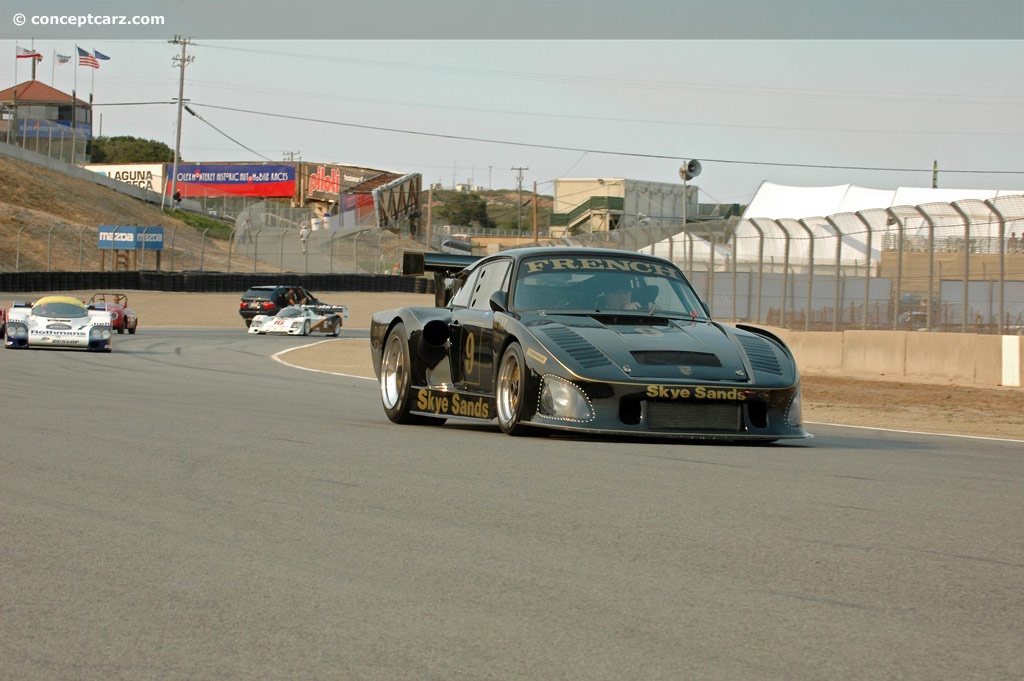
Coupe
Chassis #: 0000029
Auction entries : 1
The 1976 Le Mans 24 Hours race did not count towards either world championship, but it was nonetheless a very important race. A Renault Alpine set the pole and a 935 driven by Rolf Stommelen and Manfred Schurti qualified third and would finish the race fourth overall. The overall victory was earned by a Porsche 936. A 911 Carrera RSR placed 6th and a 908/3 Turbo placed 7th. In 9th place was a Porsche 3.0-liter turbocharged 934 and a 934/5 placed 11th.The 935 at LeMans was equipped with a 2.85-liter flat-6 engine augmented by a KKK turbocharger and its chassis weighed 900 kg, well under the 970 kg minimum stipulated for a 4.0-liter car, thus allowing ballast to improve weight distribution. The bodywork had the lights recessed into the front spoiler. The Porsche 935/77
The updated 935/77 was introduced for the 1977 season. The works team constructed 13 examples of the 935 for customer use (935/77A), wearing chassis numbers 930 770 0901 to 930 770 0913. The appearance and specification were similar to the works 935/76 and achieved great success in competition, particularly in the German DRM series. Most of the privateers were based in Italy, Australia, Germany, the United States, and France.The Deutsche Rennsport Meisterschaft (DRM) was a drivers' championship that conformed to Group 5 rules. The Porsches initially had little competition as the naturally aspirated BMW Coupes and Ford Capri had pulled out of the Division 1 (over 2.0 liter) competition. This changed when turbocharged models such as the Zakspeed Ford Capri, Toyota Celica, and BMW-powered Schnitzer threw their hats into the ring. Nonetheless, the 934 would dominate their division during the 1976 season and the 935 in 1977. The factory team focused their attention on another victory at Le Mans and remaining competition in the World Championship for Makes. Porsche had won both world championships in 1976, and with little else to prove and a lack of competition, Porsche did not defend its sportscar championship with the 936 in 1977. For the 1978 season, the series was demoted to a European series and was later discontinued. One or two factory entered 935/77 were raced during the 1977 season, winning four of the nine events. Their biggest competition was their unreliability which plagued them throughout the season. Rolf Stommelen and Manfred Schurti won the Mugello (round 2), and Jochen Mass and Jacky Ickx won Silverstone (round 3), Watkins Glen (round 5), and Brands Hatch (round 7).
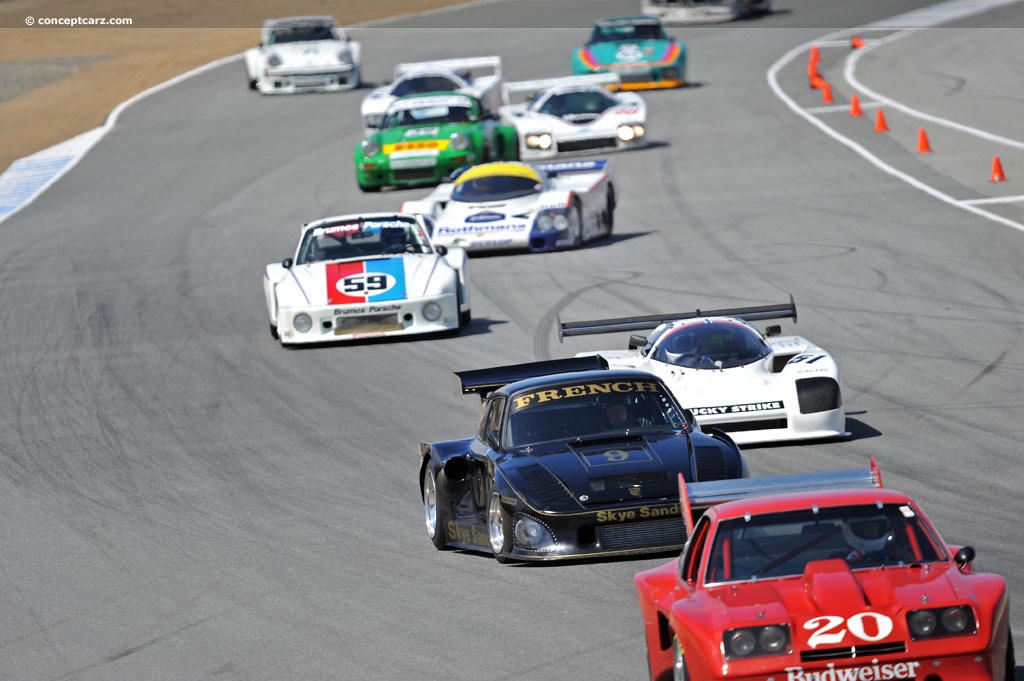
Coupe
Chassis #: 0000029
Auction entries : 1
Seventeen customer Porsche 935 chassis were built for the 1978 season, inspired by the works 935/77s. These cars were numbered 930 890 0011 to 930 890 0037 and equipped with twin-turbocharged engines, removable rear fenders, and 'running board' rocker panels. As the 1978 season was coming to a close, Porsche constructed seven 935 chassis for private teams in the United States. These 1979-model cars were numbered 930 990 0026 to 930 990 0032. The exterior was similar to the 1978-model customer's cars but was equipped with several modifications and features, including an inverted gearbox and larger brakes. The engines received a large single turbocharger, which helped it achieve higher top speeds at Daytona. Many of these, however, was eventually converted to a more versatile, twin-turbocharger arrangement.
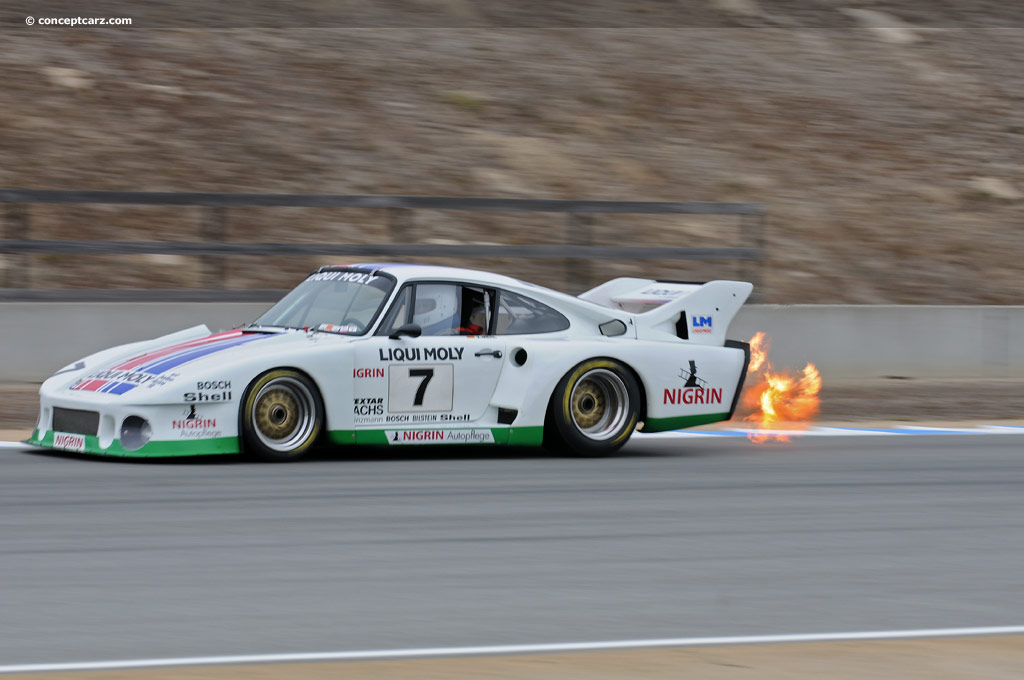
Coupe
Chassis #: 9307700958
The final version of the 935 was drastically different from the iterations that preceded it. It used a 3.2-liter engine, did away with air cooling in favor of water-cooled cylinder heads, and produced upwards of 850 horsepower. Porsche had their eyes set on Le Mans, and since the track was run clockwise, the bodywork and weight distribution were shaped to take full advantage of the long, high-speed track. The body was lowered by 3.9 inches, and the floor pan was cut away to mount the exhaust system at the front of the engine. The gearbox was mounted upside down to reduce the angle of the drive shafts and the driver seat was moved over to the right side. Additional fairings were added to the doors, bridging the gap between the front and rear fenders.
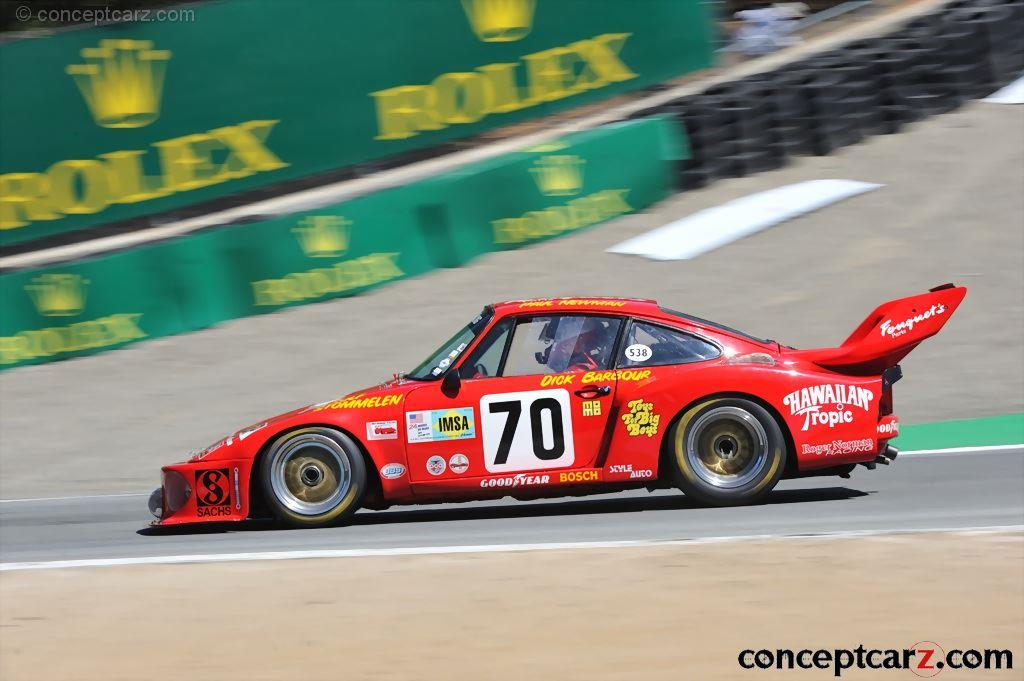
Coupe
Chassis #: 935 0090030
View info and history
Auction entries : 1
Porsche did not officially contest either the 1979 or 1980 season, leaving these duties to privateer 935, 936, 908 and 917 (albeit with some factory support - mostly in spare parts and knowledge). Racing Accomplishments
The Porsche 935 was very competitive and successful, winning over 150 races worldwide through 1985, which included an outright victory at the 1979 24 Hours of Le Mans, and over 20 class victories. They won the 24 Hours of Daytona and the 12 Hours of Sebring six times each. Between 1977 and 1979, they were undefeated in the German DRM. From 1976 to 1979, they earned Porsche victory in the FIA World Championship for Makes.
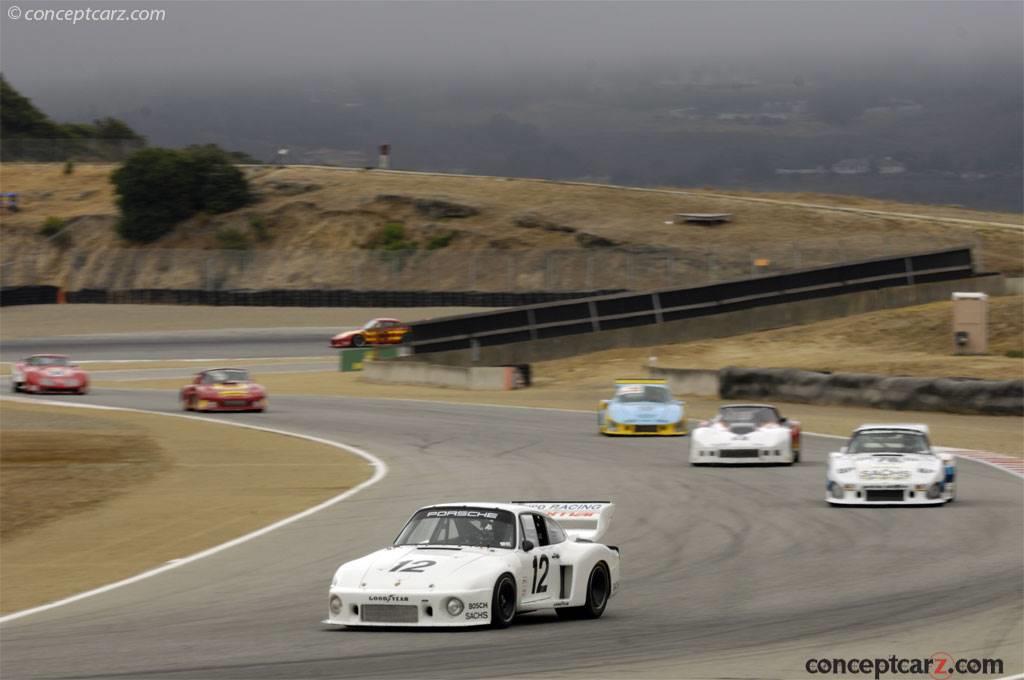
Coupe
Chassis #: 009 0029
View info and history
All of the Porsche 935 models had an 89.4-inch wheelbase except for the 935/78 which used an 89.7-inch wheelbase platform. The length measured 189.8-inches, a width of 78.1-inches, and a height of 45.3-inches. The 935/78 had different specifications with a length of 192.5-inch, a width of 78.3-inches, and a height of 47.2-inches.
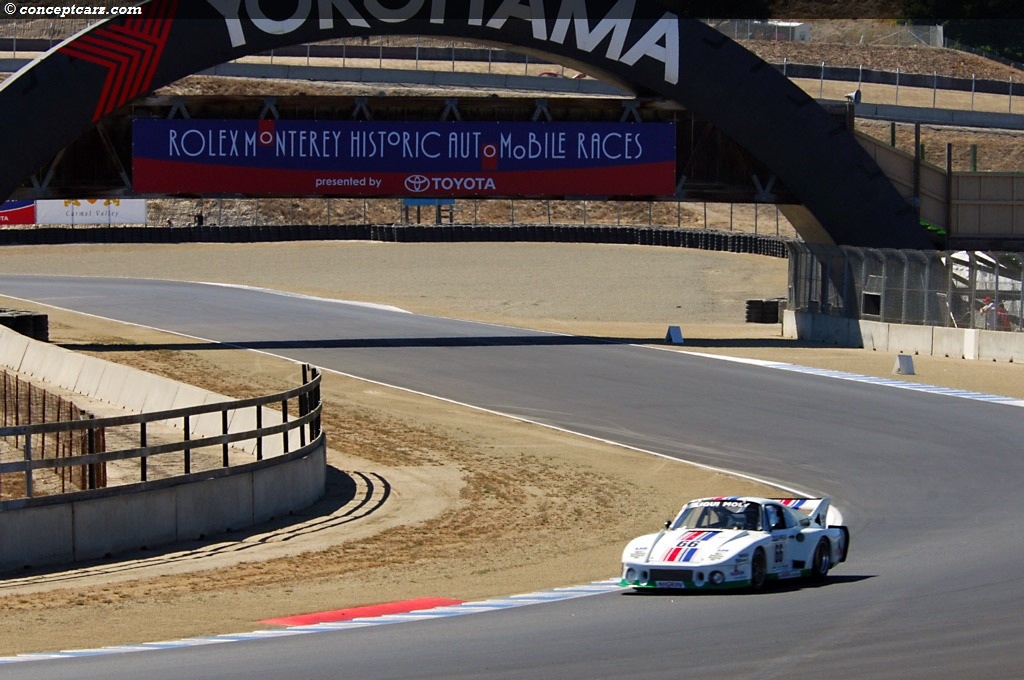
Coupe
Chassis #: 00900001
by Daniel Vaughan | Oct 2019
Related Reading : Porsche 934/935 History
In 1976, Porsche introduced a racing version of the Porsche 930911 Turbo which they dubbed, the 935. It was designed for FIA-Group 5 competition and was constructed in a similar fashion to the Porsche 934, which was used in Group 4 competition. The works team, with sponsorship by Martini, entered the 935 in the FIA World Championship for Makes with team drivers, Jacky Ickx and Jochen Mass in....
Continue Reading >>
Continue Reading >>
- 1979 Porsche 935 Menu
- Article
- Image gallery
- Valuation
- Specifications
- Profiles
1979 Porsche 935 Vehicle Profiles
Recent Vehicle Additions
Related Automotive News

Competition at the Amelia Island Concours
Competition has always been a part of the Amelia Island Concours dElegance. The core group of classes includes four Race Car groups (Prewar, 1946-57, 1958-66, 1967-83). Additionally, there are four classes reserved for Sports Cars. For those seeking...

Porsche Rennsport Reunion VI : Highlights: of man and machines
Stuttgart. The Porsche Rennsport Reunion VI at Laguna Seca (USA) has more than 60,000 fans of the brand from Stuttgart spellbound. At the four-day event in California, avid motor racing enthusiasts in legendary vehicles and unforgotten works...

Porsche Honors Hurley Haywood On 70Th Birthday
Endurance racing legend born May 4, 1948
Atlanta, Georgia. Porsche congratulates one of its most decorated ambassadors, Hurley Haywood, on a shared anniversary The five-time Rolex 24 Hours of Daytona winner turns 70 today, just a month before...

PORSCHE MOTORSPORTS PRE-EVENT NOTES. 24 HOURS OF LE MANS
The #20 Porsche 919 Hybrid with drivers (left to right) Mark Webber, Timo Bernhard, and Brendon Hartley, at Le Mans tech inspection earlier today in the town of Le Mans.
Dateline. Le Mans, France
Circuit. Circuit de la Sarthe
Track LengthTurns....
RRDC VOTES IN 37 NEW MEMBERS FOR 2013
HILLIARD, Ohio (Nov. 7, 2013) - Thirty-seven race-car drivers and motorsports professionals have been voted into the Road Racing Drivers Club in 2013. The group includes 13 Regular Members from the open-wheel and sports-car racing ranks, 20 Associate...
